
Curtisia dentata is a flowering tree from Southern Africa. It is the sole species in genus Curtisia, which was originally classed as a type of "dogwood" (Cornaceae), but is now placed in its own unique family Curtisiaceae.
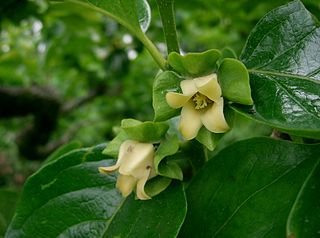
Diospyros is a genus of over 700 species of deciduous and evergreen trees and shrubs. The majority are native to the tropics, with only a few species extending into temperate regions. Individual species valued for their hard, heavy, dark timber, are commonly known as ebony trees, while others are valued for their fruit and known as persimmon trees. Some are useful as ornamentals and many are of local ecological importance. Species of this genus are generally dioecious, with separate male and female plants.

Euclea, from the Greek eukleia meaning "glory and fame", denotes a group of flowering plants in the Ebenaceae or ebony family. They were described as a genus by Linnaeus in 1774. The genus includes evergreen trees and shrubs, native to Africa, the Comoro Islands and Arabia. Several species are used for timber, producing a hard, dark heartwood timber similar to ebony.

Aloidendron dichotomum, formerly Aloe dichotoma, the quiver tree or kokerboom, is a tall, branching species of succulent plant, indigenous to Southern Africa, specifically in the Northern Cape region of South Africa, and parts of Southern Namibia.
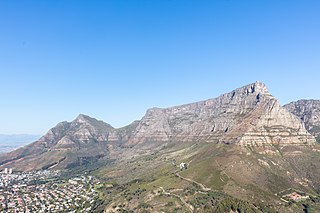
Table Mountain National Park, previously known as the Cape Peninsula National Park, is a national park in Cape Town, South Africa, proclaimed on 29 May 1998, for the purpose of protecting the natural environment of the Table Mountain Chain, and in particular the rare fynbos vegetation. The park is managed by South African National Parks. The property is included as part of the UNESCO Cape Floral Region World Heritage Site.

Leucadendron argenteum is an endangered plant species in the family Proteaceae, which is endemic to a small area of the Cape Peninsula, South Africa. Most grow in and around the city of Cape Town, but outlying populations exist near Somerset West (Silwerboomkloof), Paarl and Stellenbosch. It is a protected tree in South Africa.

Protea laurifolia, also known as the grey-leaf sugarbush, is a shrub from South Africa. It is native to the Cape Provinces of South Africa.

Gardenia thunbergia is a sturdy large shrub or small tree endemic to the southern and eastern regions of South Africa and neighbouring territories such as Eswatini. It grows largely in forest or on forest margins, occurring in the Eastern Cape, Natal and Transkei in South Africa. It is densely twiggy and rigid with smooth light-grey bark, and is horticulturally valuable, being easy to grow as a strong hedge, but more usually as a specimen plant, striking in appearance and long lived. The abundant and extremely fragrant flowers are about 70 mm in diameter with long tubes only accessible to the proboscises of nocturnal hawkmoths. The leaves are smooth, shiny, whorled and entire, and clustered at the ends of branchlets. The fruit is oval, hard, woody and fibrous, about 80 mm long and about 40 mm in diameter, light grey with small raised white spots and if not eaten by large browsers or elephant, will remain on the tree for years. Its common names include forest gardenia, mutarara, tree gardenia, white gardenia and wild gardenia. In Afrikaans it is variously known as buffelsbol, stompdoring, or wildekatjiepiering.

Widdringtonia wallichii, Clanwilliam cedar or Clanwilliam cypress, previously Widdringtonia cedarbergensis is a species of Widdringtonia native to South Africa, where it is endemic to the Cederberg Mountains northeast of Cape Town in Western Cape Province. It is threatened by habitat loss and protected in South Africa under the National Forest Act of 1998.
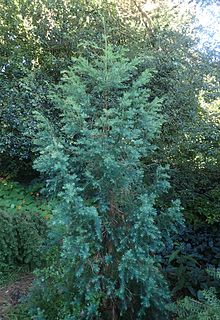
Widdringtonia schwarzii is a species of Widdringtonia native to South Africa, where it is endemic to the Baviaanskloof and Kouga Mountains west of Port Elizabeth in Eastern Cape Province; it occurs on dry rocky slopes and crags at 600-1,200 m altitude. It is threatened by habitat loss, particularly by wildfire. The Willowmore cypress is a protected tree in South Africa.

Protea aristata is a compact shrub with beautiful flowers which is endemic to the southwestern part of the Cape Region of South Africa. P. aristata has become one of South Africa's most famous proteas in spite of its relatively late discovery, and re-discovery in 1953. The leaves are soft, dense and needle-like and the flower heads are a stunning crimson red, it may thus be a good potential ornamental plant for South African gardens. It is usually called the Ladismith sugarbush in South African English, although it has been called pine sugar bush in Australia. In the Afrikaans language it has the vernacular name of klein-den-suikerbos.
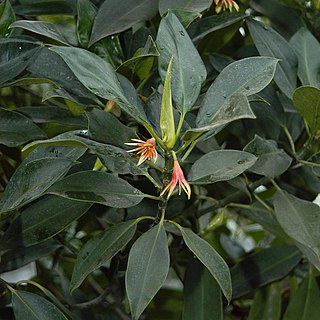
Bruguiera gymnorhiza, the large-leafed orange mangrove or oriental mangrove,) is a mangrove tree that grows usually to 7-20m high, but sometimes up to 35m, that belongs to the family Rhizophoraceae. It is found on the seaward side of mangrove swamps, often in the company of Rhizophora. It grows from the Western Pacific across Indian Ocean coasts to Cape Province, South Africa.

Cecilia is a section of the Table Mountain National Park on the lower eastern slopes of Table Mountain in Cape Town, located just to the south of Kirstenbosch National Botanical Garden. It was previously used for commercial logging and known as Cecilia Forest or Cecilia Plantation, but has now been given protected status and integrated into the National Park.

Protea acaulos, also known as the common ground sugarbush, is a flowering plant found in the southwestern Cape Region, South Africa. It is also simply known as ground protea; in the Afrikaans language it is known as an aardroos.

Protea effusa, sometimes known as the scarlet sugarbush, is a flowering plant which belongs to the genus Protea. The plant is endemic to the Western Cape province of South Africa. In the Afrikaans language the vernacular name blosrooisuikerbos has been recorded for this plant.

Protea namaquana, also known as the Kamiesberg sugarbush, is a flowering plant which belongs to the genus Protea. The plant is endemic to the southwestern Cape Region of South Africa, in particular the Kamiesberg mountains of Namaqualand in the Northern Cape province. The species has a worldwide distribution of only 18 km2. It is regarded as critically endangered. In the Afrikaans language it has the vernacular name is Kamiesbergsuikerbos.

Protea intonsa, also known as the tufted sugarbush, is a flowering plant of the genus Protea within the family Proteaceae, endemic to South Africa, where it is distributed from the eastern Swartberg and Kammanassie Mountains to the Baviaanskloof mountains. In Afrikaans it is known as klossie-suikerbos.
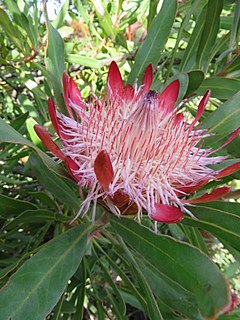
Protea susannae, also known as stink-leaf sugarbush, is a flower-bearing shrub of the genus Protea. The plant is endemic to the southwestern Cape Region of South Africa.

Protea caespitosa, also known as hottentot bishop sugarbush or bishop sugarbush, is a flowering shrub belonging to the genus Protea which is only found growing in the wild in South Africa.

Protea punctata, also known as the water sugarbush or water white sugarbush, is a shrub belonging to the genus Protea which is found growing in the wild in South Africa.





















